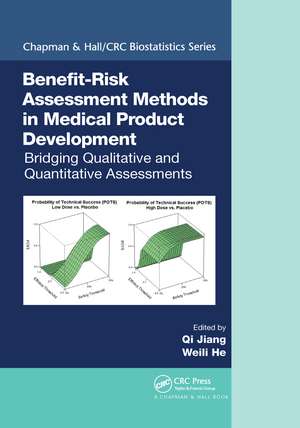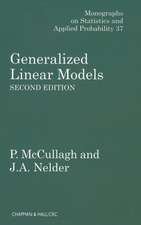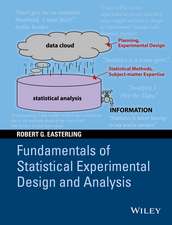Benefit-Risk Assessment Methods in Medical Product Development: Bridging Qualitative and Quantitative Assessments: Chapman & Hall/CRC Biostatistics Series
Editat de Qi Jiang, Weili Heen Limba Engleză Paperback – 18 dec 2020
Benefit–Risk Assessment Methods in Medical Product Development: Bridging Qualitative and Quantitative Assessments provides general guidance and case studies to aid practitioners in selecting specific benefit–risk (B–R) frameworks and quantitative methods. Leading experts from industry, regulatory agencies, and academia present practical examples, lessons learned, and best practices that illustrate how to conduct structured B–R assessment in clinical development and regulatory submission.
The first section of the book discusses the role of B–R assessments in medicine development and regulation, the need for both a common B–R framework and patient input into B–R decisions, and future directions. The second section focuses on legislative and regulatory policy initiatives as well as decisions made at the U.S. FDA’s Center for Devices and Radiological Health. The third section examines key elements of B–R evaluations in a product’s life cycle, such as uncertainty evaluation and quantification, quantifying patient B–R trade-off preferences, ways to identify subgroups with the best B–R profiles, and data sources used to assist B–R assessment. The fourth section equips practitioners with tools to conduct B–R evaluations, including assessment methodologies, a quantitative joint modeling and joint evaluation framework, and several visualization tools. The final section presents a rich collection of case studies.
With top specialists sharing their in-depth knowledge, thought-provoking considerations, and practical advice, this book offers comprehensive coverage of B–R evaluation methods, tools, and case studies. It gives practitioners a much-needed toolkit to develop and conduct their own B–R evaluations.
| Toate formatele și edițiile | Preț | Express |
|---|---|---|
| Paperback (1) | 313.77 lei 6-8 săpt. | |
| CRC Press – 18 dec 2020 | 313.77 lei 6-8 săpt. | |
| Hardback (1) | 531.31 lei 6-8 săpt. | |
| CRC Press – 24 mai 2016 | 531.31 lei 6-8 săpt. |
Din seria Chapman & Hall/CRC Biostatistics Series
-
 Preț: 386.63 lei
Preț: 386.63 lei - 5%
 Preț: 338.18 lei
Preț: 338.18 lei - 5%
 Preț: 656.97 lei
Preț: 656.97 lei -
 Preț: 341.43 lei
Preț: 341.43 lei -
 Preț: 355.92 lei
Preț: 355.92 lei - 8%
 Preț: 432.16 lei
Preț: 432.16 lei -
 Preț: 354.78 lei
Preț: 354.78 lei -
 Preț: 342.90 lei
Preț: 342.90 lei -
 Preț: 288.81 lei
Preț: 288.81 lei -
 Preț: 312.36 lei
Preț: 312.36 lei - 9%
 Preț: 644.58 lei
Preț: 644.58 lei - 8%
 Preț: 376.64 lei
Preț: 376.64 lei -
 Preț: 372.30 lei
Preț: 372.30 lei -
 Preț: 356.64 lei
Preț: 356.64 lei - 8%
 Preț: 531.51 lei
Preț: 531.51 lei - 9%
 Preț: 608.33 lei
Preț: 608.33 lei - 9%
 Preț: 766.28 lei
Preț: 766.28 lei -
 Preț: 378.12 lei
Preț: 378.12 lei -
 Preț: 356.64 lei
Preț: 356.64 lei - 9%
 Preț: 682.94 lei
Preț: 682.94 lei - 9%
 Preț: 594.80 lei
Preț: 594.80 lei -
 Preț: 311.47 lei
Preț: 311.47 lei -
 Preț: 362.08 lei
Preț: 362.08 lei - 9%
 Preț: 833.75 lei
Preț: 833.75 lei - 9%
 Preț: 683.12 lei
Preț: 683.12 lei - 9%
 Preț: 681.83 lei
Preț: 681.83 lei -
 Preț: 370.53 lei
Preț: 370.53 lei - 9%
 Preț: 940.39 lei
Preț: 940.39 lei - 18%
 Preț: 791.14 lei
Preț: 791.14 lei - 18%
 Preț: 702.37 lei
Preț: 702.37 lei - 18%
 Preț: 1730.31 lei
Preț: 1730.31 lei - 28%
 Preț: 875.16 lei
Preț: 875.16 lei - 18%
 Preț: 786.89 lei
Preț: 786.89 lei - 25%
 Preț: 825.63 lei
Preț: 825.63 lei - 15%
 Preț: 678.14 lei
Preț: 678.14 lei - 25%
 Preț: 557.58 lei
Preț: 557.58 lei - 29%
 Preț: 625.83 lei
Preț: 625.83 lei - 18%
 Preț: 786.38 lei
Preț: 786.38 lei - 25%
 Preț: 778.07 lei
Preț: 778.07 lei - 25%
 Preț: 628.29 lei
Preț: 628.29 lei - 18%
 Preț: 1124.97 lei
Preț: 1124.97 lei - 28%
 Preț: 881.75 lei
Preț: 881.75 lei - 25%
 Preț: 526.81 lei
Preț: 526.81 lei - 18%
 Preț: 797.46 lei
Preț: 797.46 lei - 15%
 Preț: 479.86 lei
Preț: 479.86 lei - 18%
 Preț: 1017.63 lei
Preț: 1017.63 lei
Preț: 313.77 lei
Preț vechi: 372.38 lei
-16% Nou
Puncte Express: 471
Preț estimativ în valută:
60.04€ • 64.20$ • 50.06£
60.04€ • 64.20$ • 50.06£
Carte tipărită la comandă
Livrare economică 18 aprilie-02 mai
Preluare comenzi: 021 569.72.76
Specificații
ISBN-13: 9780367737085
ISBN-10: 0367737086
Pagini: 312
Dimensiuni: 178 x 254 mm
Greutate: 0.52 kg
Ediția:1
Editura: CRC Press
Colecția Chapman and Hall/CRC
Seria Chapman & Hall/CRC Biostatistics Series
ISBN-10: 0367737086
Pagini: 312
Dimensiuni: 178 x 254 mm
Greutate: 0.52 kg
Ediția:1
Editura: CRC Press
Colecția Chapman and Hall/CRC
Seria Chapman & Hall/CRC Biostatistics Series
Cuprins
The Need for Benefit–Risk Assessment and Future Directions. Overview of Benefit–Risk Assessment and Regulatory Environment. Considerations of Benefit–Risk Assessment Development in Products’ Life Cycle Management. Benefit–Risk Assessment Methods and Visual Tools. Benefit–Risk Assessment Case Studies and Lessons Learned. Glossary. Index.
Notă biografică
Dr. Qi Jiang is an executive director of Global Biostatistical Science at Amgen. In this role, she is the biostatistical therapeutic area head for oncology and hematology and the lead of the Center of Excellence for Safety and Benefit–Risk. In addition, Dr. Jiang provides oversight to Amgen’s biostatistical efforts in the Asia–Pacific region. Before joining Amgen, she worked at the Harvard School of Public Health, Merck, and Novartis. Dr. Jiang is the co-editor of the Chapman & Hall/CRC book Quantitative Evaluation of Safety in Drug Development: Design, Analysis and Reporting and the author of more than 60 peer-reviewed publications on method development, study design, and data analysis and reporting. She is a fellow of the American Statistical Association, a co-lead of the American Statistical Association Biopharmaceutical Section Safety Working Group, a co-lead of the Quantitative Sciences in the Pharmaceutical Industry (QSPI) Benefit–Risk Working Group, and an associate editor for Statistics in Biopharmaceutical Research.
Dr. Weili He is a director of clinical biostatistics at Merck & Co., Inc. Her research interests include survival and longitudinal data modeling, missing data imputation, cancer Phase I and II designs, repeated categorical data modeling, surrogate marker evaluations, adaptive design methodologies and implementations, and methods for benefit–risk assessment. Dr. He has published extensively in the areas of adaptive designs and benefit–risk evaluations and is the author of more than 50 peer-reviewed publications in statistical and medical journals. She is also a lead editor of the book Practical Considerations for Adaptive Trial Design and Implementation. She has been actively involved in many professional activities and services, including serving as co-chair of the Quantitative Sciences in the Pharmaceutical Industry (QSPI) Benefit–Risk Working Group, co-chair of the DIA Adaptive Design Scientific Working Group (ADSWG) KOL lecture series, associate editor for Statistics in Biopharmaceutical Research, and a referee for other statistical journals.
Dr. Weili He is a director of clinical biostatistics at Merck & Co., Inc. Her research interests include survival and longitudinal data modeling, missing data imputation, cancer Phase I and II designs, repeated categorical data modeling, surrogate marker evaluations, adaptive design methodologies and implementations, and methods for benefit–risk assessment. Dr. He has published extensively in the areas of adaptive designs and benefit–risk evaluations and is the author of more than 50 peer-reviewed publications in statistical and medical journals. She is also a lead editor of the book Practical Considerations for Adaptive Trial Design and Implementation. She has been actively involved in many professional activities and services, including serving as co-chair of the Quantitative Sciences in the Pharmaceutical Industry (QSPI) Benefit–Risk Working Group, co-chair of the DIA Adaptive Design Scientific Working Group (ADSWG) KOL lecture series, associate editor for Statistics in Biopharmaceutical Research, and a referee for other statistical journals.
Recenzii
"This is one of the few books fully dedicated to the benefit–risk (BR) evaluation of pharmaceutical product. . . This book was edited by two leading experts who not only have done extensive research on the topics but also have established and led the society of clinical trial BR working group. The contributing authors in each chapter are experienced researchers and/or thought-leaders in the field. We think this book gives practitioners a much needed job aid to perform their BR evaluation."~ Journal of Biopharmaceutical Statistics
Descriere
This book provides guidance on selecting specific benefit–risk (B–R) frameworks and quantitative methods. Leading experts from industry, regulatory agencies, and academia present practical examples, lessons learned, and best practices that illustrate how to conduct structured B–R assessment in clinical development and regulatory submission. The











